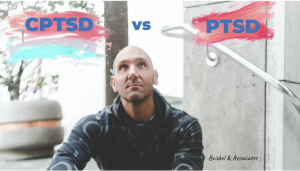How is CPTSD Different from PTSD?
 Trauma can take many forms. You may have heard of post-traumatic stress disorder (PTSD). Most people have at least heard of PTSD, as it relates to veterans. Did you know it impacts many others as well? Have you heard of complex post-traumatic stress disorder (complex PTSD or CPTSD)? People often ask how CPTSD and PTSD are similar and different. I want to help more people have a deeper understanding of what they are experiencing and ultimately get the help they deserve.
Trauma can take many forms. You may have heard of post-traumatic stress disorder (PTSD). Most people have at least heard of PTSD, as it relates to veterans. Did you know it impacts many others as well? Have you heard of complex post-traumatic stress disorder (complex PTSD or CPTSD)? People often ask how CPTSD and PTSD are similar and different. I want to help more people have a deeper understanding of what they are experiencing and ultimately get the help they deserve.
My goal, as a trauma-informed therapist, is to raise awareness and treat trauma of all kinds. When I use the word “trauma,” I am incorporating all aspects of trauma, all kinds of trauma that impact the nervous system. Trauma describes the adverse effect of any experiences that felt unsafe, physically, sexually or emotionally, or were perceived as a threat to life or survival. This includes profound emotional neglect and attachment trauma.
People can experience different kinds of symptoms depending on their experience. Trauma can come from a single incident, or from recurring incidents of emotional, physical or sexual trauma. Trauma that develops within an important early relationship, as with a parent or caregiver, can lead to attachment trauma that is complex, developmental and relational and anything in between. Relational, attachment and complex trauma are some of the traumatic variations we see most often at Brickel & Associates.
You may be asking what complex PTSD feels like or wondering if you’re facing PTSD or CPTSD. My goal is to help you see how the two are similar and different, so you can find the most helpful resources and support.
First, here’s how trauma relates to PTSD and CPTSD
PTSD (post-traumatic stress disorder) is often associated with a one-time experience or a single-incident trauma. Complex, relational and developmental trauma often results in what we call, CPTSD (complex post-traumatic stress disorder) — a form of PTSD.
Complex trauma incorporates all the symptoms of PTSD. CPTSD is different, however, from single-incident trauma because the impact on the nervous system around attachment or relationships becomes more deeply ingrained. CPTSD is relationship trauma.
Complex PTSD recovery steps
Those struggling with PTSD and CPTSD can heal. The journey for those with CPTSD just may be longer. The steps may include:
- Noticing the need and reaching out for that initial moment of help – believing that help is available and deserved can be the first step.
- Finding a trauma-informed therapist to build a therapeutic relationship.
- Building a foundation, in therapy, of stability and security to learn how to navigate life in general in the present day. Once having that foundation, practicing those skills in life’s current relationships.
- Noticing the insecure, anxious, or confusing feelings that can happen in relationships. Paying special attention to if those feelings are current or old. Are they familiar?
- Repairing these relational responses in present day to develop secure attachment, to be able to trust others who are safe and find emotional wellbeing.
Healing CPTSD starts with understanding how traumatic past relationships made a path toward distrust and hypervigilance.
Hurtful relationships left painful reminders that live on with you in your present life. Stepping back to see how the residue of the past may be tarnishing a new relationship is paramount. Learning that some relationships harm, and other kinds of relationships heal, allows for a change.
Unfortunately, as of June 2021, the diagnostic manual (DSM) for mental health includes only diagnostic criteria and codes describing PTSD. However, more therapists and mental health professionals are recognizing CPTSD as a separate condition that warrants specific treatment and support.
What is single incident trauma?
PTSD can happen at any point in life. It can develop after a car accident, a severe weather event, a mugging, a war, a medical event, a disaster or an attack. It is related to a single event or situation in which a person feels unable to escape danger or feel safe.
Single-incident trauma often results in PTSD (post-traumatic stress disorder).
Single-incident trauma can often allow for healing faster if the individual who experienced the trauma has a secure foundation from childhood. When we treat single incident trauma, it usually resolves easier, leaving less residue on the nervous system. Single incident traumas are often treated using a therapy like EMDR.
What is Complex PTSD (CPTSD)?
Complex trauma, on the other hand, often develops during an earlier stage of development, over repeated incidents, involving a relationship that is supposed to be safe.
The brain and nervous system adapt to expecting ongoing danger, often compromising the development of a healthy sense of self and the world. These adaptations then become deeply instilled in a person’s thinking, feeling and functioning. For example, you may develop constant hypervigilance or hypoarousal as a means of coping with a childhood history of abuse and/or neglect.
Because of this, complex trauma is deeper and often takes longer to repair and heal.
How are PTSD and CPTSD different?
Relationships are likely triggering for a person with CPTSD. A survivor of single-incident trauma may be triggered by lots of things — sounds, smells, etc. — but not usually by relationships or attachments. That is what makes CPTSD particularly challenging to treat, as healthy relationships are fundamental to recovering from trauma. If a close relationship is what has harmed you in the first place, it may take longer to develop the trust needed to heal and recover from CPTSD.
Unlike survivors of single-incident trauma, complex trauma survivors (those with CPTSD) likely:
- Experienced abuse or neglect during their formative years from a primary caregiver or person who was involved in a close relationship in their life.
- Had a hard time figuring out what was right or wrong because behaviors of caregivers didn’t make sense.
- Could not be present with others in their daily life at the time, because it was not safe.
- Struggle to be present, in their life as adults, because everyday life and relationships still feel unsafe.
- May not know how to “do” relationships.
- May continue to experience similar traumas in new relationships.
- Have an imprint of past trauma on their nervous system.
- Live in a “triggered” state of hyperarousal or hypoarousal, because it’s how they learned to survive.
- May not even be aware they have experienced complex trauma, having to live with symptoms instead of narrative memories.
- May not realize they have survived anything, let alone something so influential in their development.
- May not see any separation from who they are as a person and the complex trauma that happened to them.
- Are consumed by trauma symptoms every day.
- May not realize that they can experience life any differently.
How are all traumas similar?
All forms of trauma are similar, because the experience leaves people feeling unsafe and in danger. Trauma-informed therapist, Lisa Ferentz, LCSW lists these common characteristics of trauma:
- A traumatic event, either witnessed or experienced, representing a fundamental threat to one’s physical integrity or survival.
- Responses involve a range of possible emotions including intense fear, helplessness, horror, disempowerment, anger or rage
- Shame/guilt/”badness”/embarrassment
- Grief/Bereavement
Yes, you can reclaim your life after trauma!
Trauma survivors don’t always know there is another way to experience life than to battle fear and symptoms every day. They may need to learn that in adulthood they can heal, nurture themselves with compassion, or even re-parent their inner child who is crying out in pain. They may also learn that there are consistent, caring, safe people in the world. Trauma survivors may not realize that they can experience life any differently, but they can!
Healing from complex trauma and CPTSD
Trauma survivors who have experienced complex trauma often have a greater challenge recognizing trauma’s impact because it has become entwined with their fundamental understanding of the world and themselves. It became part of their foundation in the world. In therapy, survivors are building a new foundation, one of stability, consistency, and safety in order to heal. They are learning that relationships can be safe, that they can be vulnerable and stay safe, and that connections help with healing.
Healing is possible!
Resources:
- 3 Concepts to Help Trauma Survivors Move Forward into Healthier Relationships
- Loving a Trauma Survivor: Understanding Childhood Trauma’s Impact on Relationships
- Book: A Practical Guide to Complex PTSD | Dr. Arielle Schwartz
- Workbook: Transforming the Living Legacy of Trauma: A Workbook for Survivors and Therapists by Janina Fisher
4 Comments
Comments are closed.










Thank for information seeing my wife go though an some ether doctors ether no some on not how others do think something wrong. I work with M. S. Home allot people there can’t help what’s going on.
What about trauma from several events? Is this “additive”? Complex versus single-event, leaves out multiple events, non relationship
I was so happy to see this article! For one, it let me know that I’m not the only one going through this, and two, I now have a name for what I’m experiencing.
As with most things, the younger you are the easier to overcome. The more years the more regret and the more “complex.” The problem is that the brain rationalized abnormal behavior so it seems rational. Until it’s too late. And then the dam breaks. And the suffering and regret can seem existential. With hindsight comes clarity. With clarity … and loss … come regret.